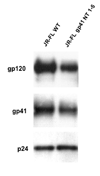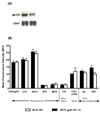N-terminal substitutions in HIV-1 gp41 reduce the expression of non-trimeric envelope glycoproteins on the virus
- PMID: 18031785
- PMCID: PMC2317825
- DOI: 10.1016/j.virol.2007.10.018
N-terminal substitutions in HIV-1 gp41 reduce the expression of non-trimeric envelope glycoproteins on the virus
Abstract
The native, functional HIV-1 envelope glycoprotein (Env) complex is a trimer of two non-covalently associated subunits: the gp120 surface glycoprotein and the gp41 transmembrane glycoprotein. However, various non-functional forms of Env are present on virus particles and HIV-1-infected cells, some of which probably arise as the native complex decays. The aberrant forms include gp120-gp41 monomers and oligomers, as well as gp41 subunits from which gp120 has dissociated. The presence of non-functional Env creates binding sites for antibodies that do not recognize native Env complexes and that are, therefore, non-neutralizing. Non-native Env forms (monomers, dimers, tetramers and aggregates) can also arise when soluble gp140 proteins, lacking the cytoplasmic and transmembrane domains of gp41, are expressed for vaccine studies. We recently identified five amino acids in the gp41 N-terminal region (I535, Q543, S553, K567 and R588) that promote gp140 trimerization. We have now studied their influence on the function and antigenic properties of JR-FL Env expressed on the surfaces of pseudoviruses and Env-transfected cells. The 5 substitutions in gp41 reduce the expression of non-trimeric gp160s, without affecting trimer levels. Pseudovirions bearing the mutant Env are fully infectious with similar kinetics of Env-mediated fusion. Various non-neutralizing antibodies bind less strongly to the Env mutant, but neutralizing antibody binding is unaffected. Hence the gp41 substitutions do not adversely affect Env structure, supporting their use for making new Env-based vaccines. The mutant Env might also help in studies intended to correlate antibody binding to virus neutralization. Of note is that the 5 residues are much more frequent, individually or collectively, in viruses from subtypes other than B.
Figures








Similar articles
-
Stabilization of the soluble, cleaved, trimeric form of the envelope glycoprotein complex of human immunodeficiency virus type 1.J Virol. 2002 Sep;76(17):8875-89. doi: 10.1128/jvi.76.17.8875-8889.2002. J Virol. 2002. PMID: 12163607 Free PMC article.
-
Enzyme digests eliminate nonfunctional Env from HIV-1 particle surfaces, leaving native Env trimers intact and viral infectivity unaffected.J Virol. 2011 Jun;85(12):5825-39. doi: 10.1128/JVI.00154-11. Epub 2011 Apr 6. J Virol. 2011. PMID: 21471242 Free PMC article.
-
Specific amino acids in the N-terminus of the gp41 ectodomain contribute to the stabilization of a soluble, cleaved gp140 envelope glycoprotein from human immunodeficiency virus type 1.Virology. 2007 Mar 30;360(1):199-208. doi: 10.1016/j.virol.2006.09.046. Epub 2006 Nov 7. Virology. 2007. PMID: 17092531 Free PMC article.
-
HIV-1 envelope glycoprotein biosynthesis, trafficking, and incorporation.J Mol Biol. 2011 Jul 22;410(4):582-608. doi: 10.1016/j.jmb.2011.04.042. J Mol Biol. 2011. PMID: 21762802 Free PMC article. Review.
-
HIV-1 envelope glycoprotein structure.Curr Opin Struct Biol. 2013 Apr;23(2):268-76. doi: 10.1016/j.sbi.2013.03.007. Epub 2013 Apr 18. Curr Opin Struct Biol. 2013. PMID: 23602427 Free PMC article. Review.
Cited by
-
Alterations in gp120 glycans or the gp41 fusion peptide-proximal region modulate the stability of the human immunodeficiency virus (HIV-1) envelope glycoprotein pretriggered conformation.J Virol. 2023 Sep 28;97(9):e0059223. doi: 10.1128/jvi.00592-23. Epub 2023 Sep 11. J Virol. 2023. PMID: 37696048 Free PMC article.
-
Functional stability of unliganded envelope glycoprotein spikes among isolates of human immunodeficiency virus type 1 (HIV-1).PLoS One. 2011;6(6):e21339. doi: 10.1371/journal.pone.0021339. Epub 2011 Jun 27. PLoS One. 2011. PMID: 21738637 Free PMC article.
-
Immunogenicity of Stabilized HIV-1 Envelope Trimers with Reduced Exposure of Non-neutralizing Epitopes.Cell. 2015 Dec 17;163(7):1702-15. doi: 10.1016/j.cell.2015.11.056. Cell. 2015. PMID: 26687358 Free PMC article.
-
In-solution virus capture assay helps deconstruct heterogeneous antibody recognition of human immunodeficiency virus type 1.J Virol. 2010 Apr;84(7):3382-95. doi: 10.1128/JVI.02363-09. Epub 2010 Jan 20. J Virol. 2010. PMID: 20089658 Free PMC article.
-
Native-like Env trimers as a platform for HIV-1 vaccine design.Immunol Rev. 2017 Jan;275(1):161-182. doi: 10.1111/imr.12481. Immunol Rev. 2017. PMID: 28133806 Free PMC article. Review.
References
-
- Allaway GP, Davis-Bruno KL, Beaudry GA, Garcia EB, Wong EL, Ryder AM, Hasel KW, Gauduin MC, Koup RA, McDougal JS, et al. Expression and characterization of CD4-IgG2, a novel heterotetramer that neutralizes primary HIV type 1 isolates. AIDS Res Hum Retroviruses. 1995;11(5):533–539. - PubMed
-
- Binley JM, Sanders RW, Clas B, Schuelke N, Master A, Guo Y, Kajumo F, Anselma DJ, Maddon PJ, Olson WC, Moore JP. A recombinant human immunodeficiency virus type 1 envelope glycoprotein complex stabilized by an intermolecular disulfide bond between the gp120 and gp41 subunits is an antigenic mimic of the trimeric virion-associated structure. J Virol. 2000;74(2):627–643. - PMC - PubMed
Publication types
MeSH terms
Substances
Grants and funding
LinkOut - more resources
Full Text Sources
Other Literature Sources

